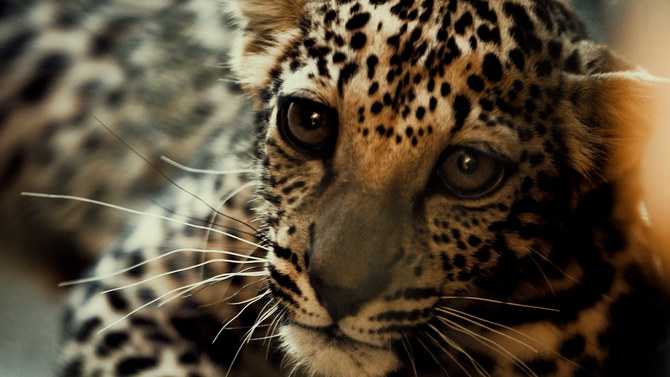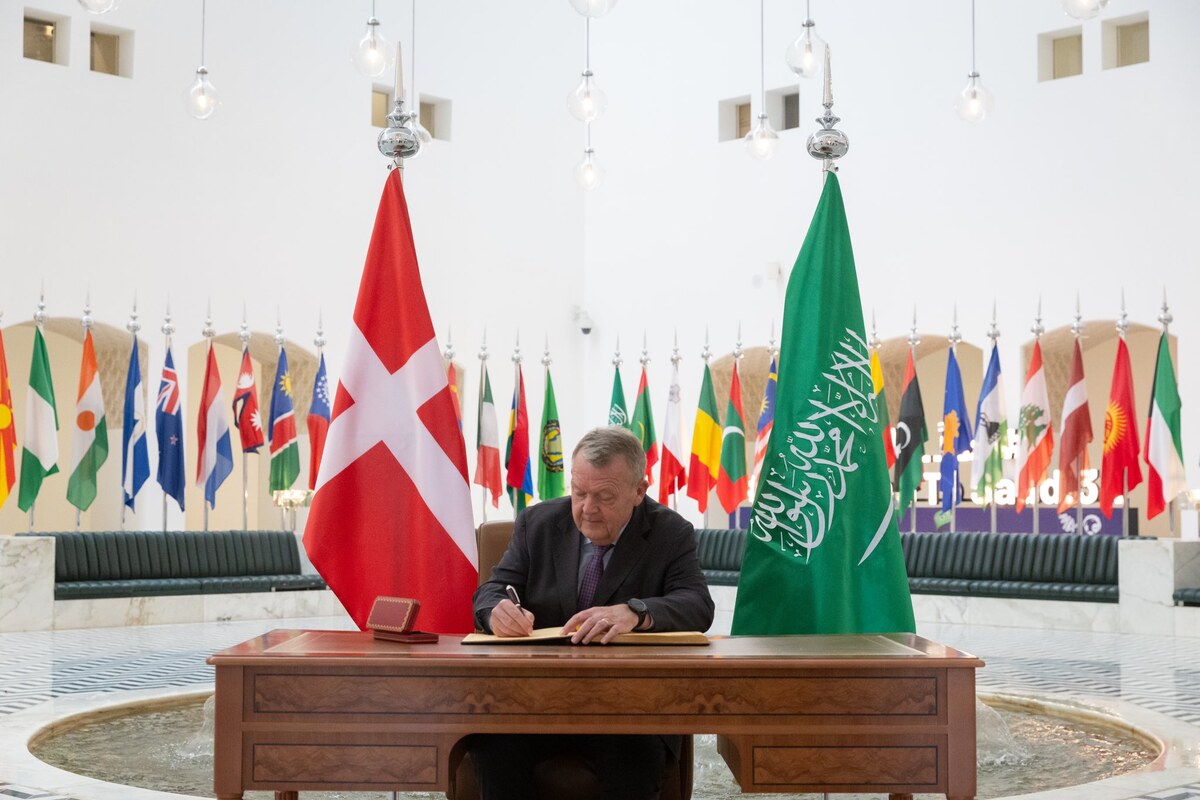LONDON: Abdulaziz Alenzy will never forget the moment last April when he got the call. After more than three months of anxious waiting, one of the leopards in the captive breeding program at the Wildlife Research Center in Taif had finally given birth to a healthy, feisty cub.
“I cannot describe my feelings when she was born,” said Alenzy, veterinary manager at the Royal Commission for AlUla. “We were expecting a cub to be born that day, but when I got the call from the keepers it was, ’Wow!’ I got up, got dressed and rushed to work.”
For 12 weeks the team left mother and cub undisturbed — the first three months of life can be touch-and-go for a new-born leopard. Only then were they able to carry out a medical examination, when they discovered that “we were blessed with a female cub, which is a great thing for our program.”
On that cub, one of 16 that have so far been bred successfully in Taif as part of an Arabian Leopard Program being managed by the RCU, rests the hopes of one of the most ambitious rewilding experiments ever attempted anywhere in the world.
“Our goal at RCU is nothing less than to restore the power of nature’s balance,” said Dr. Ahmed Mohammed Al-Malki, the commission’s director general of nature reserves.
Working in partnership with Panthera, a global conservation organization dedicated to preserving the world’s seven big cats and their critical role in global ecosystems, the RCU plans to reintroduce the leopard to the wild in Saudi Arabia.
“We believe that saving endangered species such as the Arabian leopard is critical to the protection of our planet and the natural balance of our ecosystem,” Al-Malki said.
Right now, the Arabian leopard is classified on the International Union for Conservation of Nature’s Red List as “critically endangered.” It is all but extinct in the wild.
Only a handful of the magnificent animals are thought to survive in the whole Arabian Peninsula, holding out in a last refuge in Oman’s Dhofar mountains.
In Saudi Arabia, where, for generations, the animal and its prey were hunted and its habitat steadily eroded by human expansion and development, the leopard is feared to be extinct.
“I don’t think we can say for certain that the leopard is extinct in Saudi Arabia,” said biologist David Mallon, visiting professor in the department of natural sciences at Manchester Metropolitan University and a member of the IUCN Red List Committee.
“There could still be the odd animal or two hanging on somewhere. But over the past few years a lot of camera trapping has been carried out. This has been much intensified by the Panthera people, working with AlUla at a dozen sites over the past two years, but they haven’t found any photographs of the leopard.”
FASTFACT
* Famous buildings and landmarks in Saudi Arabia, UAE and Oman were lighting up to mark the very first Arabian Leopard Day on Feb. 10.
The leopard was already rare in Saudi Arabia by the 1960s. The last confirmed sighting in the Kingdom was in 2014, when a video was posted on YouTube of a leopard that had been poisoned by a farmer in the Wadi Numan area of Makkah.
That was the starting point for the RCU, which, even as the breeding of leopards goes ahead, is embarking on an education and awareness program designed to highlight the importance, and the benefits to local communities, of restoring the leopard to its ancient hunting grounds.
This will help communities to realize “there is a direct link between their prosperity, their future, and the fact that the leopard is being reintroduced,” said Thomas Kaplan, founder of Panthera. “(The most important part of) the process of reintroducing big cats is to ensure the buy-in of local populations.”
For its part, the RCU is “working hand-in-hand with the local community,” investing in “education and learning for AlUla’s next generation to create training and employment opportunities.”
The opportunity to see leopards in the wild will doubtless play a significant part in the development of the AlUla region as a cultural tourism destination rich in archaeology, heritage and stunning landscapes — one that creates many jobs for local people.

Princess Reema bint Bandar Al-Saud, the Saudi ambassador to the US, is founder of Catmosphere, a non-profit foundation that aims to raise awareness of the many endangered cat species around the world. (Screenshot/Instagram)
The RCU plans to release the first captive-bred leopards into the Sharaan Nature Reserve by 2030. The reserve is a protected habitat of 925 square kilometers being created at AlUla, in the dramatic canyon landscape east of the ancient rock-carved Nabateaen city of Hegra.
The timing could not be more perfect. The AlUla project — establishing the area as an international tourist destination rich in natural and human history — is one of the cornerstones of the Kingdom’s Vision 2030 blueprint for economic diversification.
The location is also perfect. Leopards, along with lions and cheetahs, lived in this very place for millennia before they lost the fight for living space with humans.
Evidence that the animals thrived here for thousands of years — alongside lions and cheetahs, now both long extinct — can be found in ancient rock carvings, or petroglyphs, scattered across the landscape, showing leopards prowling what was then the lush, verdant landscape of the Arabian Peninsula.
Now, says Kaplan, the leopard is coming home — and that is a vital step in Saudi Arabia’s broader plans to dramatically increase the number of protected habitats in the country.
“The beauty of saving the big cats is that they stand at the top of the pyramid in terms of the food chain,” he said. “Think of them as the umbrella species or the apex predator — the iconic megafauna within its ecosystem. It is the representation of a healthy landscape; a one-stop-shop for wildlife conservation.

Right now, the Arabian leopard is classified on the International Union for Conservation of Nature’s Red List as “critically endangered.” It is all but extinct in the wild. (Supplied/RCU Images)
“In other words, if you want to save large landscapes, then the way to go about it is to focus on the top of the food chain, the umbrella species. And in Saudi Arabia, that is the leopard.”
The commitment to the leopard program runs deep. In June 2016, in an open-air ceremony amid the stunning scenery of the AlUla landscape, Prince Badr bin Abdullah bin Farhan, Saudi Arabia’s minister of culture and RCU governor, signed an agreement with Panthera, committing the commission to investing $20 million over 10 years to aid global conservation of the leopard and to revitalize the Arabian leopard population.
Prince Badr said after the ceremony: “It is our duty to protect, conserve and build the population numbers to preserve the species from becoming a footnote in history,” and to “ensure that populations in other countries around the world are preserved before they reach the levels of endangerment faced today by our precious native big cats.”
Preserving animals means preserving landscapes, and the leopard program is the flagship in a fleet of green initiatives being launched to restore and protect the balance of nature across the Kingdom, building on previous successes including the reintroduction of other threatened species and the designation of great swathes of the country as protected areas.
Following the launch of the Saudi Green Initiative in March 2021, other rewilding initiatives are under way across the Kingdom, including the reversal of desertification across vast areas, the restoration of habitats degraded by livestock overgrazing, and a huge planned increase in the number and scale of protected areas in Saudi Arabia.
The first protected area in the country was established in 1986 — a 13,775-square-kilometer reserve at Harrat al-Harrah in the north of the Kingdom. Today, it is home to a dazzling array of important animals, including the Reem gazelle, Arabian wolf, red fox, sand fox, striped hyena, Cape hare, jerboa, houbara bustard and golden eagle.
Since the designation of Harrat al-Harrah, a total of 14 other areas, covering more than 82,000 square kilometers, have been protected. Now, under the auspices of the Saudi Green Initiative, there are plans to increase the area of protected land to roughly 600,000 square kilometers — more than 30 percent of the Kingdom’s total land area.
Saudi Arabia has already successfully reintroduced the Arabian oryx to the wild — a prime example, according to Kaplan, of what can be achieved.
By 1972 the oryx, once common across the Arabian Peninsula, had been hunted to extinction in the wild. But, bred from captive specimens, by 1982 the species had been reintroduced in Oman, with subsequent reintroductions in Saudi Arabia and the UAE.
Remarkably, by 2011 the status of the species on the IUCN Red List had been changed from extinct to vulnerable — the first time that a vanished species had ever made such a dramatic comeback.
“The recovery of the Arabian oryx has turned out to be one of the most inspirational case studies for captive breeding and reintroduction of any species anywhere in the world, and one of the most powerful models we have for the successful reintroduction of the Arabian leopard itself,” said Kaplan.
“Everyone involved in that program remembers when the first Arabian oryx was born in captivity. They had no idea that it was going to be as successful as it was.
“But we certainly do believe that with the births of the cubs in Taif we are seeing the first paw prints of the success of the Arabian leopard initiative.”
































